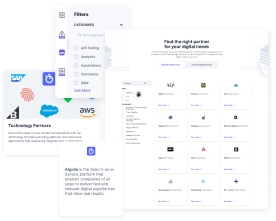How to create a content model in a headless CMS
6 min. read
Creating exceptional digital experiences that are both engaging and well-organized is a daunting task for content creators and developers. A well-thought-out content model is imperative to achieve this goal. But what does a content model entail, why is it crucial, and what steps are involved in creating one? This guide will explore these questions and steer you through the steps for developing a successful content model.
What is a content model?
A content model is like a map or plan that shows how to set up and arrange things on an app or website. It helps developers who make the apps or websites decide how everything should look and where to put it all. This makes the app or website easier for people to use. If the team makes a good content model at the start of a project, they can work better and faster. Plus, they can avoid making big changes or do-overs later, saving time and money.
A content model is like a picture guide. It shows the order of information, how different kinds of content connect to each other, and how everything flows on a page. This tool is important when planning an app or a website. It helps make sure the end result is easy to understand, fun to interact with, and user-friendly.
Content modeling is an essential step in using a content management system. Through detailed documentation of the type of content, its attributes, and its relationships, you can create a model that establishes rules for how different types of content interrelate. By structuring and organizing your content, you can ensure it is easy to find and understand.
The task of making a content model is a key part of managing content well. A model helps keep things uniform and makes using an app or website better because it offers a set way that makes finding specific things easier. It can help you create a smooth and easy-to-understand experience for users.
Importance of content modeling
When creating content, whether for a website or a mobile app, it's essential to understand how that content will be structured and presented clearly. It helps to ensure consistency across different pieces of content and enables developers and content producers to work together more efficiently. Let's take a closer look at why content modeling is so important for developers and producers.
For developers
For developers, content modeling streamlines creating a website or application. This structured approach helps maintain data consistency and enhances searchability, providing a seamless user experience. It eases integration, as each important content type and its attributes are defined, reducing the chances of coding errors or miscommunications.
By making a good content model, developers can make sure their work can grow and adapt. This means they can add new types of content or change existing ones without having to redo their systems. This is handy as what you need from content can change over time. It helps businesses stay up-to-date and keep up with what their customers or clients want as their needs change.
For content producers
A robust content model for content producers represents a better way to manage your content development. It clarifies what information needs to be collected for each content type, making the content creation process more streamlined.
Moreover, with a defined structure in place, content producers can focus on creating quality content, assured that it will be correctly displayed and easily discoverable. Ultimately, a model of your content ecosystem can aid in improving the overall content strategy by ensuring the consistency, relevance, and accessibility of content.
How to create a content model: A step-by-step guide
Step 1: Identify your content types
Start with identifying the different types of content your business deals with. Content types are the various forms of data that your organization generates. For instance, if you run a news website, your content types might be blog posts, editorials, features, table of contents, and author profiles. An eCommerce store might have products, user reviews, user profiles, and transaction history as content types.
To identify these types, look at the content you currently have and anticipate the content you will need in the future. This involves understanding your business objectives, what you want to communicate to your audience, and what type of content is required to achieve these goals.
Step 2: Define the attributes
Once you have identified your content types or classes, the next step is to list the attributes or fields that each type should contain. These are the individual pieces of information that make up each content type.
For instance, the attributes of a business article content class could include title, author, publish date, body content, tags, and featured image. For a product in an eCommerce store, attributes might consist of product name, SKU, price, description, product images, and product reviews.
Step 3: Establish relationships
Different content types often have relationships with each other, and you need to map these out. Understanding these relationships is key to structuring your content effectively.
For example, an author writes articles on a news website, so there's a relationship between the author's content type and the article's content type. Similarly, a product on an eCommerce website might be linked to user reviews, creating a relationship between the product and review content types.
Step 4: Create the model
At this point, you should understand your content types, their attributes, and their relationships. The next step is creating a visual model representing all this information.
You can do this using various diagramming tools available online, such as draw.io, Lucidchart, or even offline tools like Microsoft Visio. Your content model should visually represent all your content types, their attributes, and the relationships between them.
This model serves as a visual guide for anyone in your organization who works with content. It also aids in discussions with developers and designers when creating or refining the systems that handle your content.
Step 5: Review and refine
Once you have created your content model, review it carefully to make sure it meets your current and future business needs. Check if it aligns with your business goals, and refine it where necessary.
It's important to note that your content model isn't set in stone. As your business evolves, your content model should evolve too. Regularly review and update the model as required to ensure it continues to serve your business needs efficiently and effectively.
Creating a content model can be a significant task, but it's an essential part of any content strategy. By having a solid content model, you can ensure your content is well-organized, easy to manage, and structured in a way that helps your business achieve its goals.
Conclusion
Content modeling is a crucial element of a successful content management system. It provides structure and organization, facilitating efficient content creation, delivery, and management. Whether you're a developer looking for streamlined integration and scalability or a content producer aiming for effective content strategy and delivery, understanding how to create a content model is essential.
You can create a content model by figuring out what kinds of content you have, deciding what parts they need, understanding how they connect, making the model, and improving it. This will help ensure everything fits together nicely, is relevant, and provides a smooth user experience.
Even though the job might seem big and scary at first, keep in mind that a good content model is great because it can change and grow as your content needs do. So, don't see content modeling as a one-off task but rather as an ongoing adventure towards making high-quality, impactful content.
Learn more
Learn more about creating a content model in our article Content Modeling and Headless CMS: A Match Made for the Future of Content.
Schedule a free demo to see how Contentstack's composable content experience platform can help your organization create a content model.
Related Articles
Here are other CMS articles we think you'll find useful.






.jpg?format=pjpg&auto=webp)

